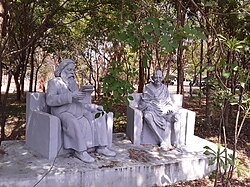
Mysore, officially Mysuru, is a metropolitan city in the southern Indian state of Karnataka. It is the third-most populous and third-largest city in the state, and is one of the cleanest cities in India. It is the seat of the Wadiyar dynasty and was the capital of the Kingdom of Mysore for almost six centuries, from 1399 until 1947. It is currently the headquarters of Mysore district and Mysore division. Known for its heritage structures and palaces, including the famous Mysore Palace, and noted for its culture, Mysore is popularly known as the "City of Palaces", the "Heritage City", and the "Cultural Capital of Karnataka". For its pristine and calm ambience, it is also known as "Pensioners' Paradise".
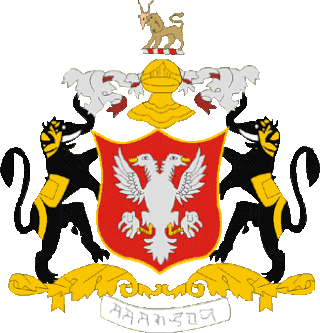
The Wadiyar dynasty, is a late-medieval/early-modern South Indian Hindu royal family of former kings of Mysore from the Urs clan originally based in Mysore city.

The Kingdom of Mysore was a realm in southern India, traditionally believed to have been founded in 1399 in the vicinity of the modern city of Mysore. From 1799 until 1950, it was a princely state, until 1947 in a subsidiary alliance with British India. The British took Direct Control over the Princely State in 1831. It then became Mysore State with its ruler remaining as Rajapramukh until 1956, when he became the first Governor of the reformed state.

Raj Bhavan, Karnataka is the official residence of the governor of Karnataka located in Bengaluru city, in the State of Karnataka, India. Constructed in the late 18th century.
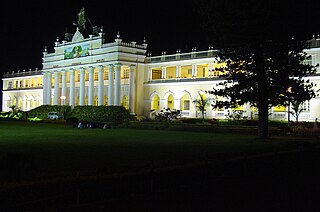
The University of Mysore is a public state university in Mysore, Karnataka, India. The university was founded during the reign of Maharaja Krishnaraja Wadiyar IV and the premiership of Sir M. Visvesvaraya. The university is recognised by the University Grants Commission for offering higher studies degree courses on-campus as well as online. It was inaugurated on 27 July 1916. Its first chancellor was the maharaja himself; the first Vice-Chancellor was H. V. Nanjundaiah. This was the first university outside of British administered Indian provinces, the sixth in the Indian subcontinent as a whole, and the first in Karnataka. It is a state university of the affiliating type, and was deemed autonomous within the Republic of India on 3 March 1956, when it gained recognition from the University Grants Commission.

Mysore Medical College and Research Institute, also known as Government Medical College, Mysore is one of the oldest medical colleges in India. It is located in the heart of the city of Mysore adjacent to the city railway station. Founded in 1924 by Maharaja Krishnaraja Wadiyar IV, it is the first medical college to be established in the Karnataka region and the seventh in India. The college is affiliated to the Rajiv Gandhi University of Health Sciences, Jayanagar, Bangalore.

Kukkarahalli Lake also called Kukkarhalli Kere, located in the heart of the Mysore city, adjoins the Manasgangotri, the Kalamandir (Rangyana) and the Central Food Technological Research Institute (CFTRI) campus. It provides lung-space to the city. Mummadi Krishnaraja Wodeyar (1794–1868) of the Mysore dynasty was responsible for getting the lake created, in the year 1864, to provide water for irrigation to about 4000 ha of land outside the city. The Lake also used to be a source of water supply to the city of Mysore but over the years, sewage and excessive land encroachments and blockage of water flow sources almost led to the eutrophication of the lake. The University of Mysore and the citizen forums of Mysore continue to make efforts to preserve the lake by implementing several remedial measures. There is a 3.5-km walkway on the periphery of the lake with shaded stone benches for visitors to sit, relax and enjoy the scenic serenity of the lake.

The Chamundi Hills are located 13 km east of Mysore, Karnataka, India. The name comes from the Chamundeshwari Temple at the peak. The average elevation is 1,060 metres (3,480 ft).

Mysore Palace, also known as Amba Vilas Palace, is a historical palace and a royal residence (house). It is located in Mysore, Karnataka, India. It used to be the official residence of the Wadiyar dynasty and the seat of the Kingdom of Mysore. The palace is in the centre of Mysore, and faces the Chamundi Hills eastward. Mysore is commonly described as the 'City of Palaces', and there are seven palaces including this one. However, the Mysore Palace refers specifically to the one within the new fort.

Mysore district, officially Mysuru district, is an administrative district located in the southern part of the state of Karnataka, India. It is the administrative headquarters of Mysore division.Chamarajanagar District was carved out of the original larger Mysore District in the year 1998. The district is bounded by Chamrajanagar district to the southeast, Mandya district to the east and northeast, Kerala state to the south, Kodagu district to the west, and Hassan district to the north.
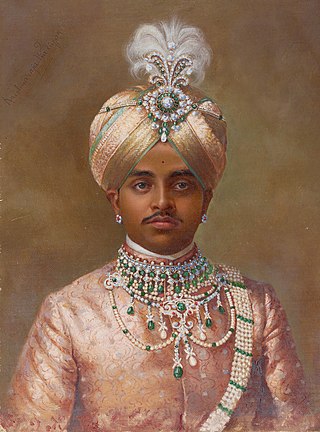
Krishnaraja Wadiyar IV (Kannada: ಶ್ರೀ ನಾಲ್ವಡಿ ಕೃಷ್ಣರಾಜ ಒಡೆಯರು; 4 June 1884 – 3 August 1940) was the twenty-fourth Maharaja of Mysore, reigning from 1902 until his death in 1940.

The maharaja of Mysore was the king and principal ruler of the southern Indian Kingdom of Mysore and briefly of Mysore State in the Indian Dominion roughly between the mid- to late-1300s and 1950. The maharaja's consort was called the maharani of Mysore.

Victoria Hospital is a government run hospital affiliated with Bangalore Medical College now renamed Bangalore Medical College and Research Institute. It is the largest hospital in bangalore, India. Started by Shri Krishnaraja Wodeyar, the then Maharaja of Mysore in 1901, the hospital soon rose to be among the prominent hospitals in South India. Dr. Padmanabhan Palpu, a famous doctor and bacteriologist from Kerala was instrumental in setting up the hospital.
Chamarajendra Academy of Visual Arts (CAVA) is a visual art school in Mysore, in the state of Karnataka in India. The academy is affiliated to the University of Mysore and offers courses in drawing, painting, sculpture, graphics, applied arts, photography and photo-journalism and art history. CAVA awards degrees in Bachelor of Fine Arts (BFA) and Master of Fine Arts (MFA).
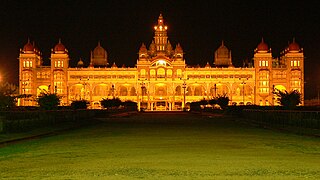
Mysore is a city in the state of Karnataka, India. It is known as the cultural capital of Karnataka. Mysore was the capital of the Wodeyar kings who ruled over the Mysore Kingdom for many centuries. Wodeyars were great patrons of art and music and have contributed significantly to make Mysore a cultural centre. Mysore is well known for its palaces, museums and art galleries and the festivities that take place here during the period of Dasara attract a worldwide audience. Mysore has also lent its name to popular dishes like Mysore Masala Dosa and Mysore Pak. Mysore is also the origin of the popular silk sari known as Mysore silk sari and has also given rise to a popular form of painting known as Mysore painting.


Janopakari Doddanna Setty, (1840–1921), was an Indian merchant and philanthropist from Bangalore, Mysore State, British India. He is known for starting the Sri Lakshmi Narasimha Institution for free education to help poor students in 1906, and he also built a public function hall, popularly called "Doddanna Hall", which used to host cultural and public activities in 1905, and later converted into Paramount Talkies.
